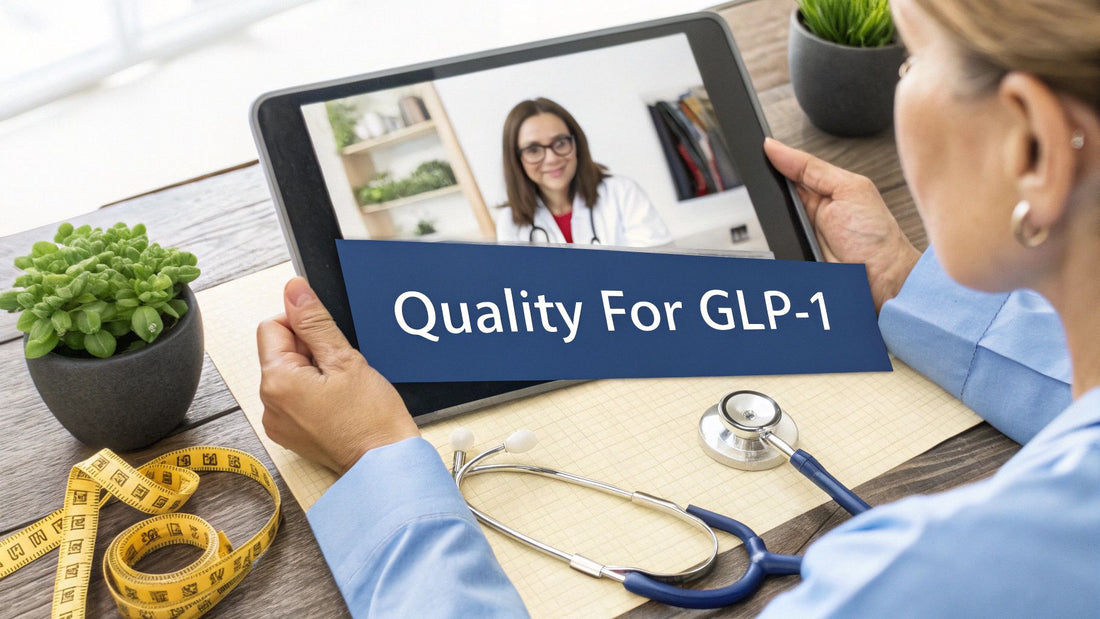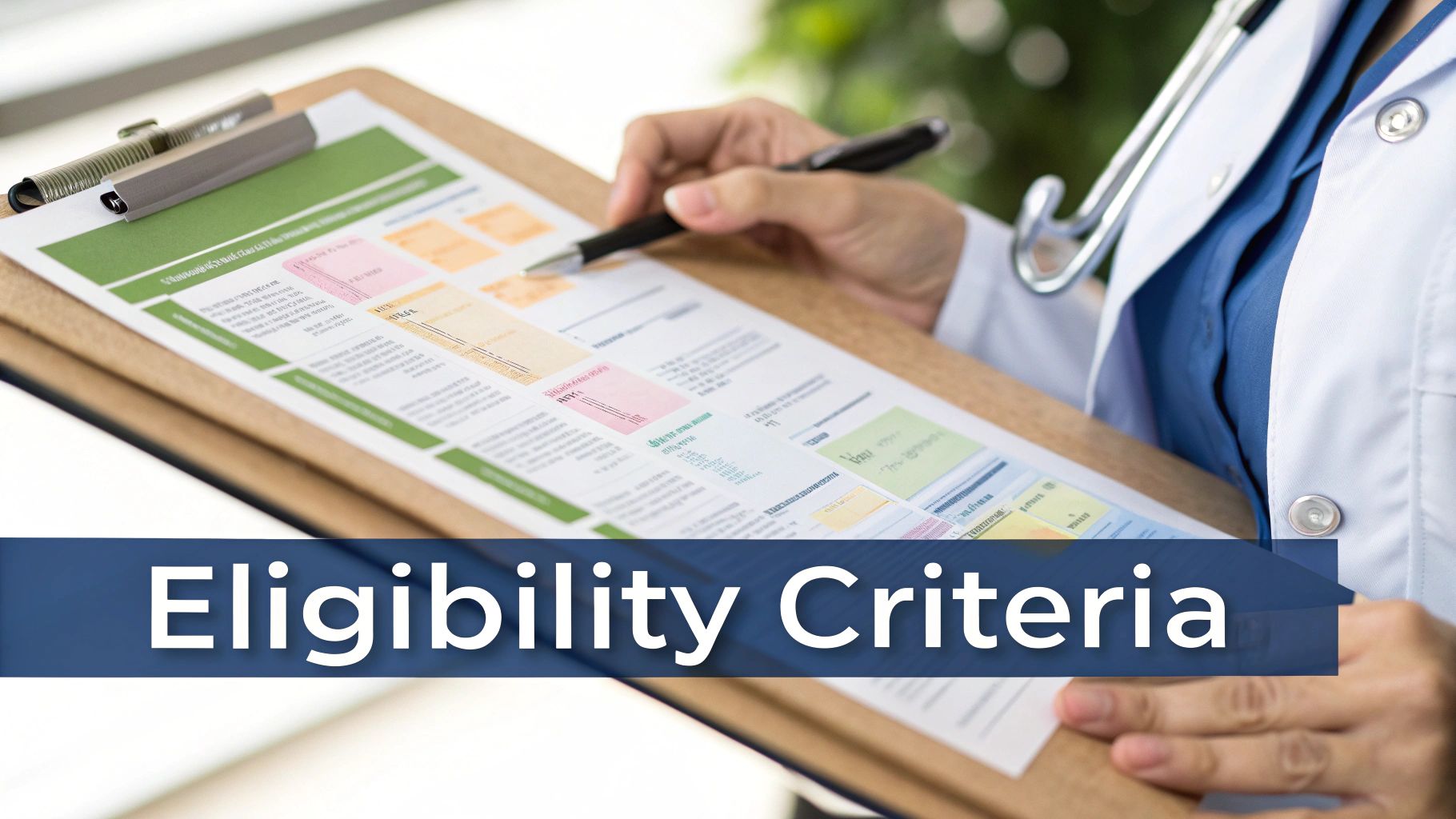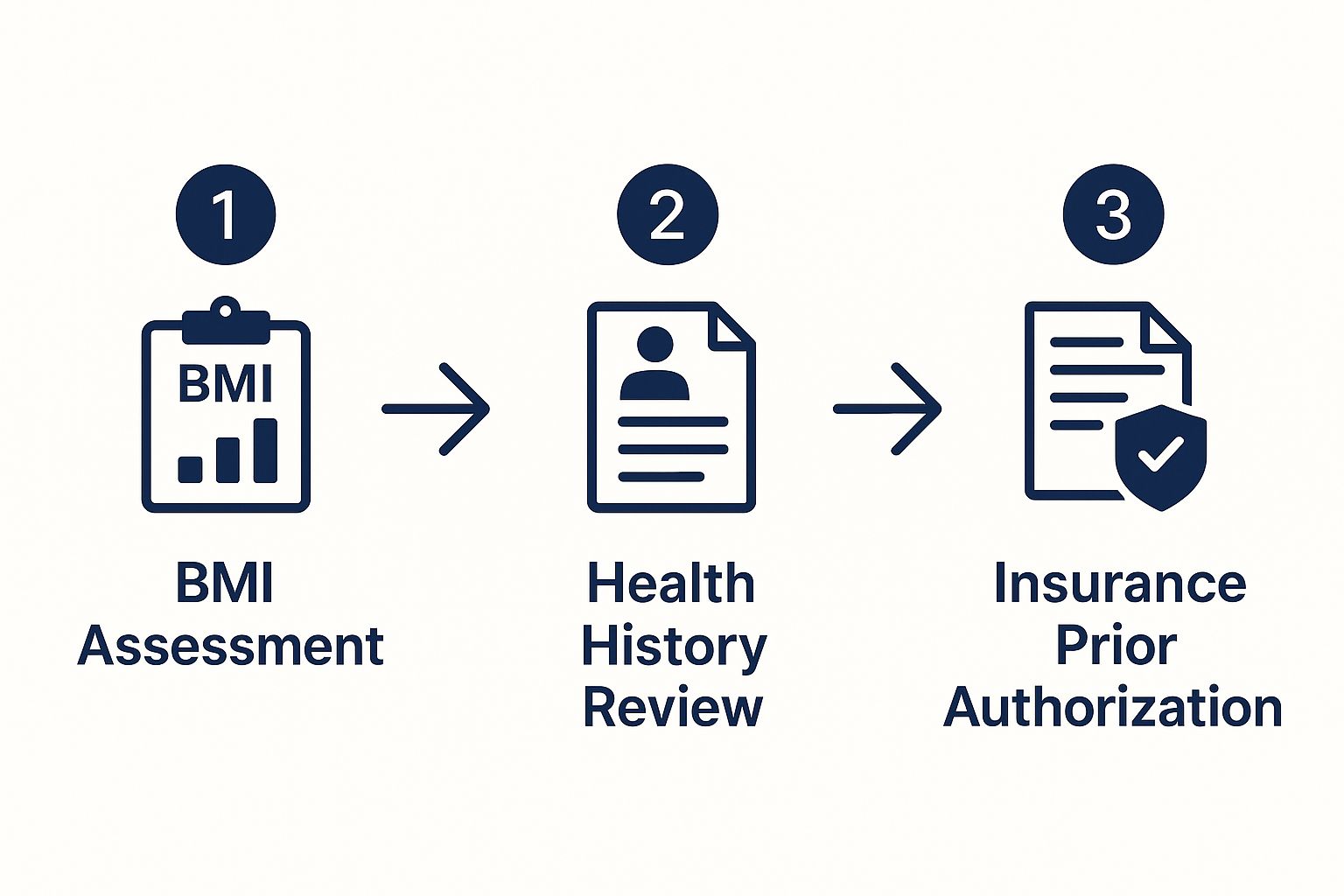
How to Qualify for GLP-1: Your Guide to Eligibility & Next Steps
Share
If you're curious whether GLP-1 therapy is the right path for your health journey, you've come to the right place. Understanding the qualification process is the first step, and it's simpler than you might think. It primarily comes down to two key factors: your Body Mass Index (BMI) and any weight-related health conditions you may be managing.
Think of these as the starting points for a conversation with a healthcare provider. They help create a clear picture of your overall health and show where GLP-1s could make a meaningful difference in your long-term wellness.
Your Path to GLP-1 Therapy Explained
Many people are exploring these medications as a tool for sustainable weight management, and the good news is the criteria are quite straightforward. They are designed to ensure the treatment is offered to individuals who can gain the most significant health benefits.
The journey isn't just about a number on the scale. A provider will look at your complete health profile to see if this approach aligns with your long-term goals for healthy living.
Core Qualification Markers
When a clinician assesses your eligibility, they're typically looking for one of two scenarios:
- You have a Body Mass Index (BMI) of 30 or higher, which is the clinical definition of obesity.
- You have a BMI of 27 or higher (considered overweight) and you're managing at least one health issue linked to weight.
What kind of health issues are we talking about? Common examples include high blood pressure, high cholesterol, type 2 diabetes, or sleep apnea. Having one of these conditions alongside a BMI of 27 or more often indicates that your weight is actively impacting your overall wellness.
If you want to dive deeper into how these medications support weight management, you can learn more about GLP-1 for weight loss in our detailed article.
Quick Guide to GLP-1 Qualification Markers
To make it even simpler, here's a quick table breaking down the key health markers that providers look at. It's a handy reference to see where you might stand.
| Qualification Marker | What It Means | Common Threshold |
|---|---|---|
| Body Mass Index (BMI) | A measure of body fat based on height and weight. | 27+ (with a comorbidity) or 30+ |
| Weight-Related Comorbidity | A health condition caused or worsened by excess weight. | At least one, like high blood pressure or high cholesterol. |
This table shows how these two factors work together. A provider will consider both to determine if GLP-1 therapy is a safe and effective option for your health journey.
Why These Criteria Matter
You might be wondering why these specific numbers are so important. These guidelines are in place for your safety and to ensure that GLP-1s are prescribed responsibly to people whose health can genuinely improve with weight loss. This isn't just about appearance; it’s about reducing serious health risks and supporting a longer, healthier life.
The number of people who could benefit is significant. One analysis revealed that around 57.4 million adults under 65 with private health insurance in the U.S. could be eligible based on having a BMI of 30+, or a BMI of 27+ with a related condition like hypertension.
The bottom line is that GLP-1 therapy is about more than just shedding pounds. It's a tool for improving your metabolic health and lowering the risks tied to weight-related conditions.
Getting started is probably easier than you think. The first step is often a simple online assessment to see if you might be a candidate.
Do You Qualify? A Look at the Medical Criteria for GLP-1s

Before you can begin a GLP-1 medication, you'll need to meet certain medical benchmarks. Knowing what those are ahead of time can make your conversation with a healthcare provider feel much more comfortable and productive. It’s not about passing a test; it's about painting a clear picture of your health to see if this treatment is a good fit for you.
Everything starts with a few key numbers, the most common being your Body Mass Index (BMI). While it’s not the whole story, it’s a quick, standardized way for providers to get a sense of your current health status.
To be considered for these medications, you typically need to fall into one of two groups:
- A BMI of 30 or higher, which is the clinical definition of obesity.
- A BMI between 27 and 29.9 (overweight), plus at least one weight-related health condition.
It’s About More Than Just Your BMI
That second point is where the real nuance comes in. A BMI score is just a starting line—it doesn't tell the full story of your health. Your provider needs to connect the dots between your weight and your overall well-being.
For example, a person with a BMI of 28 who has perfectly normal blood pressure and cholesterol is in a very different situation than someone with the same BMI who's already taking medication for high cholesterol. The presence of that related condition suggests that excess weight is already creating other health problems.
A provider's goal is to see the complete picture. Having a condition like high blood pressure or pre-diabetes provides critical context, often making a stronger case that medical intervention could offer significant benefits for your long-term health.
This thorough approach ensures that GLP-1s are prescribed to people who stand to gain the most, not just in terms of weight loss, but in improving their longevity and quality of life.
Common Weight-Related Health Conditions
So, what are these "weight-related conditions" that providers look for? They're typically chronic issues that often improve when a person manages their weight effectively. If you're looking into prescription weight loss medication, having a diagnosis for one of these can be a key factor.
Here are the most common ones:
- High Blood Pressure (Hypertension): If you're already on medication for high blood pressure, it’s a clear sign your cardiovascular system is under strain.
- High Cholesterol (Dyslipidemia): This means you have elevated levels of "bad" (LDL) cholesterol or triglycerides, which are major risk factors for heart disease.
- Prediabetes or Type 2 Diabetes: Problems with blood sugar control are a hallmark of metabolic stress. GLP-1s were originally developed to address these issues, so they are especially effective here.
- Sleep Apnea: This is a condition where breathing repeatedly stops and starts during sleep, often made worse by excess weight.
Imagine someone who's been taking blood pressure medication for years but struggles to manage their weight. For them, a GLP-1 could be a game-changer, helping with weight and potentially improving the very cardiovascular markers they’re already trying to manage.
Understanding these criteria helps you have a much more focused and effective discussion with a provider. You'll be ready to talk about your health goals and figure out if a GLP-1 is the right tool to help you reach them.
How the Telehealth Qualification Process Works
Taking that first step with a telehealth platform can feel a little different, but the process is designed to be straightforward, private, and supportive. Everything is built around your convenience, letting you get started right from home. It all begins with a simple online assessment.
This initial quiz is more than just a form—it's the first step in building your health profile. You'll answer specific questions about your medical history, your current health, and your weight management goals. This gives our clinical team a solid snapshot of your situation, helping them see if you're a potential fit before you even schedule a consultation.
Your Virtual Consultation
Once you've completed the online assessment, the next step is a one-on-one virtual consultation with a licensed U.S. healthcare provider. This is your dedicated time to discuss the details. The provider will have reviewed your quiz answers, but they'll want to ask follow-up questions to get the complete picture of your health.
Being open and honest here is absolutely essential. Your provider needs to know about:
- Your full medical history, including any past surgeries or ongoing conditions like high blood pressure or diabetes.
- All current medications and supplements you're taking. This is critical for avoiding any potential interactions.
- Your past experiences with weight loss, including what has and hasn't worked for you before.
This is a genuine conversation, not an interrogation. The provider's only goal is to make sure GLP-1 therapy is a safe and appropriate choice for you. This personalized attention is one of the biggest benefits of modern telehealth. You can learn more in our guide on how to get prescription weight loss medication online.
Quality telehealth is built on trust and open communication. Your virtual visit is a completely confidential space to ask questions, share your concerns, and start building a partnership with a provider who understands your goals.
This visual breaks down the key stages you'll go through on your qualification journey.

As you can see, the process moves logically from checking your BMI to a thorough review of your health history—these are the two most critical pieces of the puzzle.
Moving Forward with Confidence
This careful, step-by-step process ensures every decision is made with your safety and long-term health as the top priority. By combining the information you provide with a professional medical evaluation, we can confidently determine if you're eligible and map out a plan that truly aligns with your goals. The whole experience is designed to feel empowering, not intimidating.
Once your provider confirms you're a good candidate, they'll issue your prescription and lay out a personalized treatment plan. This is the official start of your journey, backed by a medical team dedicated to helping you succeed.
Why Your Full Health History Matters

While numbers like BMI give us a starting point, they're just a snapshot. To determine if a GLP-1 program is the right move for you, a healthcare provider needs to see the bigger picture—your entire health history.
Think of your personal health journey as a collection of valuable clues. It’s not just about what conditions you have now. It’s about what you’ve tried before, what worked, what didn't, and the challenges you've faced. Having this information ready for your consultation can make the process smoother and more effective.
Painting the Full Picture for Your Provider
Your consultation is a conversation. The more detail you can share, the better your clinician can design a plan that truly works for you and supports your long-term success.
A provider will want to explore a few key areas beyond your current weight and health stats:
-
Past Weight Loss Attempts: Be open about what you've tried in the past. Perhaps a certain diet gave you great results for a few months, or you found an exercise routine you loved. Sharing these experiences helps your provider understand your body's patterns.
-
Current Medications: This is a big one. You need to list everything you take—prescriptions, over-the-counter meds, and even daily supplements like NAD+. This is critical for ensuring a new treatment fits safely with your current routine.
-
Family Medical History: Does heart disease or type 2 diabetes run in your family? This information gives your provider important context about your own potential health risks.
Looking at your health from all these angles allows a provider to make a truly informed decision, not just one based on a few numbers on a chart.
Your health history is a roadmap. It shows where you've been and helps your provider chart the best course forward. A GLP-1 is most effective when it’s part of a plan that considers your entire journey.
Your Lifestyle and Readiness for Change
Beyond your medical chart, your daily life and mindset play a huge role. Your provider will want to get a feel for your current habits and your readiness to make lasting changes.
Why? Because GLP-1 therapy works best when paired with positive lifestyle adjustments. If you're already putting in the effort to eat well and stay active, a GLP-1 can amplify those efforts and help you break through a plateau.
Expect to talk about your eating habits, how much you move your body, and your personal wellness goals. This isn't about judgment; it’s about building a partnership to get you where you want to go.
By understanding your full story, a provider can make sure your treatment plan is not only safe but also realistic for your life. If you're ready to see if you qualify, the first step is our simple online quiz.
What Happens After You Qualify for GLP-1s?
Getting the green light for a GLP-1 medication is a huge step forward. It's helpful to think of it as the starting line of a new chapter in your health journey, not the finish line.
The real transformation begins now, as you integrate this powerful new tool into your daily life. Success isn’t just about the medication itself—it's about building a solid, supportive routine around it.
Adherence Is Your Superpower
If there’s one piece of advice to take to heart, it’s this: consistency is everything. Taking your medication exactly as prescribed, without skipping doses, is what allows it to work effectively. This steady presence in your system helps regulate your appetite and blood sugar, paving the way for sustainable, long-term results.
It sounds simple, but life can get in the way. In fact, research shows that sticking with it can be a real challenge for many.
A revealing study on GLP-1 persistence found that only about a third of new users were still taking their medication after one year. Even more striking, just 27% were using it as consistently as directed.
Interestingly, the study found that users aged 35-64 were 40-50% more likely to stick with the treatment than younger adults. This suggests that life experience and established routines can be a huge advantage.
Your commitment to consistent use is the single most powerful factor you can control. It transforms the medication from a temporary fix into a reliable tool for lasting change.
What to Expect Day to Day
So, what does this new routine look like? Most GLP-1s are a simple, once-weekly injection. Your provider will walk you through the process, and you’ll likely be surprised at how quickly it becomes a normal part of your weekly schedule.
It's also important to be prepared for some potential side effects, especially as your body adjusts. Most are mild and related to digestion.
Common side effects can include:
- Nausea or an upset stomach
- Noticeable changes in your appetite
- Some fatigue
These typically improve significantly over the first few weeks. Practical tips like eating smaller, more frequent meals and sipping water throughout the day can make a big difference. Always keep an open line of communication with your provider. If anything feels off, let them know.
Our guide on how to get Semaglutide offers even more practical tips for managing your first few weeks. Regular check-ins are key to tracking your progress and ensuring you feel fully supported.
Remember, this is a journey of steady progress. If you're ready to take the next step, it all starts with our simple online quiz.
Common Questions About Getting Started with GLP-1s
It’s completely normal to have questions when you’re looking into something new for your health. You're probably wondering about the specifics—what BMI do I need? What if I don't have diabetes? How does telehealth work?
Let's get you some clear, trustworthy answers to the most common questions we hear.
Is There a Magic BMI Number I Need to Hit?
There’s no single "magic" number, but there are standard medical guidelines.
Generally, you may be a candidate if your Body Mass Index (BMI) is 30 or higher. You might also qualify with a BMI of 27 or higher if you're also managing a weight-related health issue, like high blood pressure, sleep apnea, or high cholesterol.
Think of these numbers as a starting point. A licensed provider will look at your entire health picture during your consultation to make the final determination.
Can I Get a GLP-1 Prescription If I Don't Have Type 2 Diabetes?
Yes, absolutely. This is one of the biggest misconceptions.
While these medications first became known for treating type 2 diabetes, many are now recognized for their role in chronic weight management for people without diabetes. The focus is on your BMI and overall health, not a specific diagnosis.
A provider's decision to prescribe a GLP-1 through a program like ours hinges on your need for a weight management tool. It’s about your health journey as a whole.
How Long Will It Take to Get Approved Through Telehealth?
We know you don't want to get stuck in a long process. That's why the entire system is designed for your convenience.
It all starts with a quick online quiz that takes just a few minutes to complete.
After that, a licensed provider reviews your information, and you'll have a virtual consultation, which can often be booked within a couple of days. We work hard to remove the waiting and help you get started as soon as it's medically appropriate.
Are There Any Age Limits for GLP-1s?
For the most part, GLP-1 medications are prescribed for adults. While you may hear about them being used in adolescents for specific medical reasons, our program at Blue Haven Rx is designed for adults looking to manage their weight as part of a healthy lifestyle.
During your consultation, your provider will confirm that you meet the age and health criteria to safely move forward.
At Blue Haven Rx, we’re focused on providing you with a clear, supportive path forward on your health and wellness journey. If you feel that GLP-1 therapy might be the right next step for you, the best way to find out is to start.
Take our free, no-obligation quiz to see if you qualify.